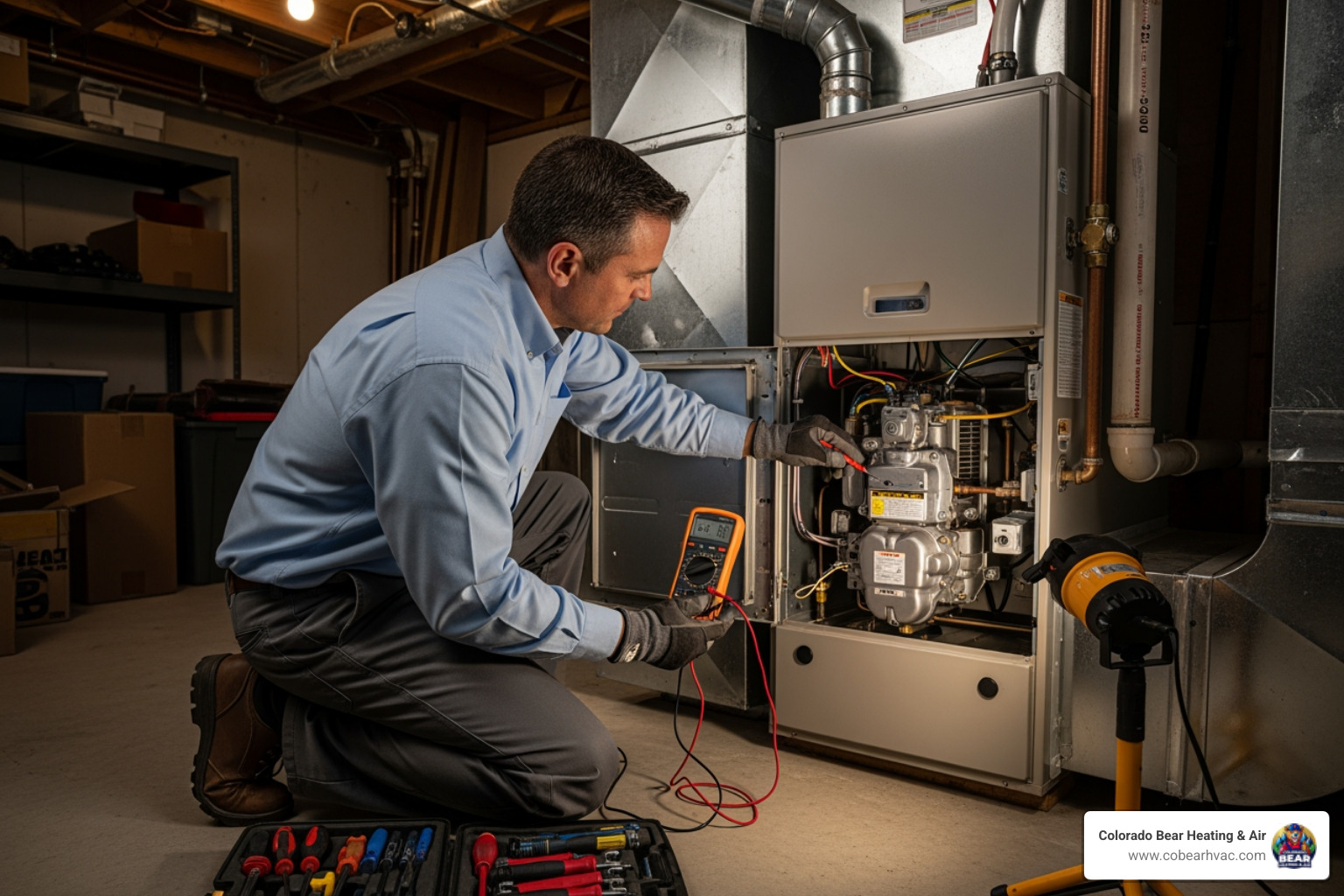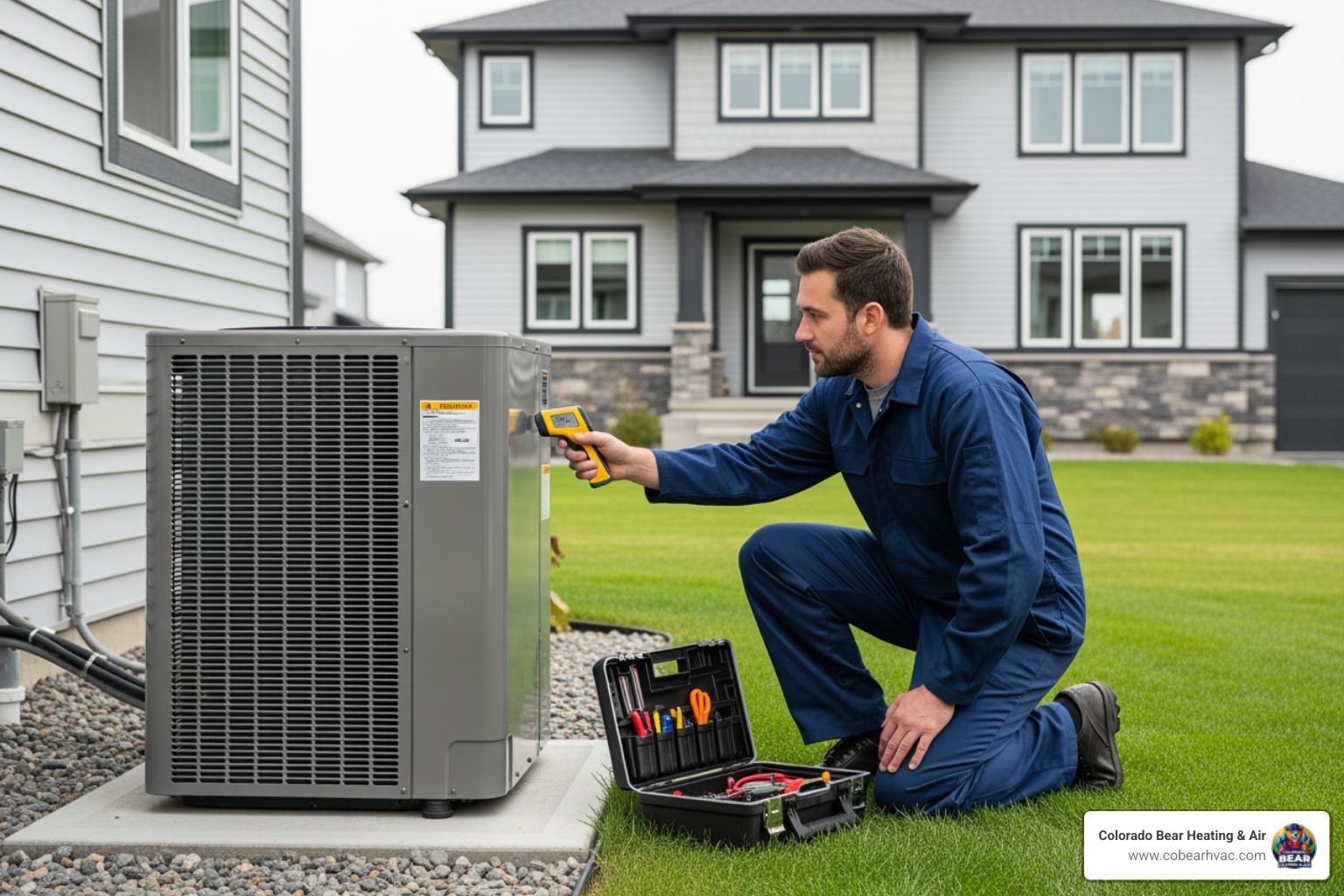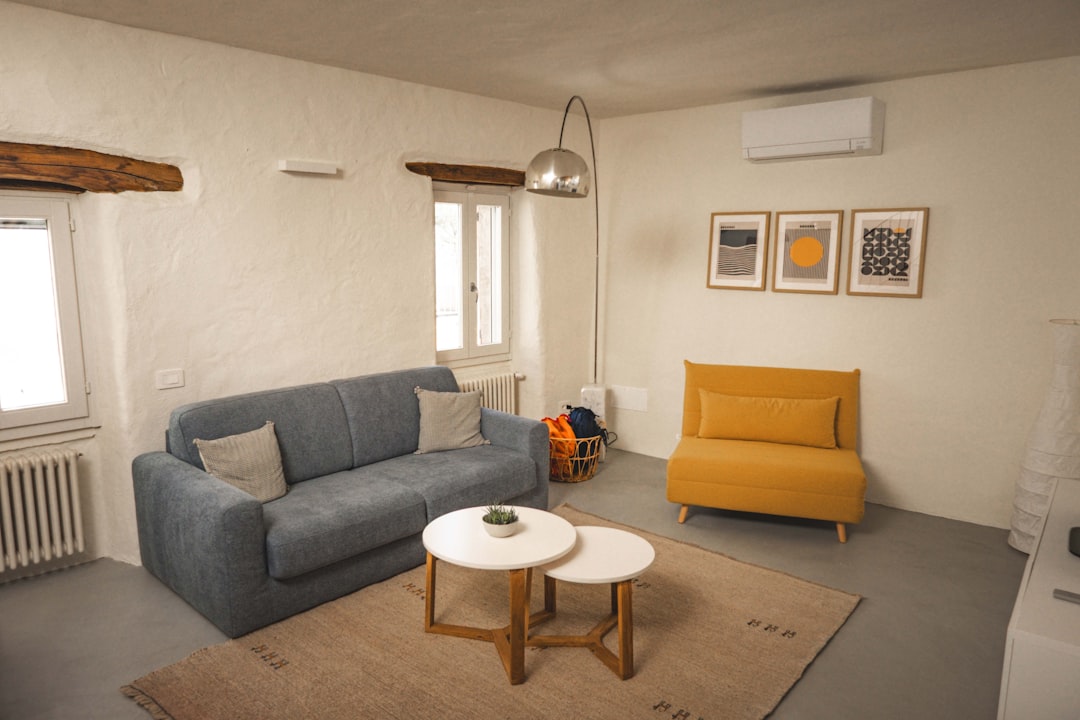


Why Formaldehyde Air Pollution Matters in Your Colorado Home
Formaldehyde air pollution is a common but overlooked issue in many Colorado homes. This colorless gas, a volatile organic compound (VOC) with a sharp, pickle-like odor, off-gasses from everyday items like furniture, flooring, and building products. While invisible, it can cause eye irritation, breathing problems, and long-term health risks like cancer. Understanding its sources and solutions is key to a healthy home.
Quick Answer: Formaldehyde Facts
- What it is: A colorless gas (VOC) that becomes airborne at room temperature.
- Sources: Pressed-wood furniture, cabinets, flooring, paints, and fabrics.
- Health Effects: Eye/throat irritation, coughing, asthma triggers, and long-term cancer risk.
- Indoor Levels: Typically 20-40 ppb, but much higher in new or renovated homes.
- Safe Limit: Below 40 ppb for long-term exposure (Health Canada).
- Solutions: Ventilation, choosing low-VOC products, and controlling temperature/humidity.
In Colorado, formaldehyde levels often spike in new homes, after renovations, or during hot summers when off-gassing accelerates. If you're concerned about your air, understanding indoor air quality fundamentals is the first step. Our indoor air quality services can help you find the right solutions.
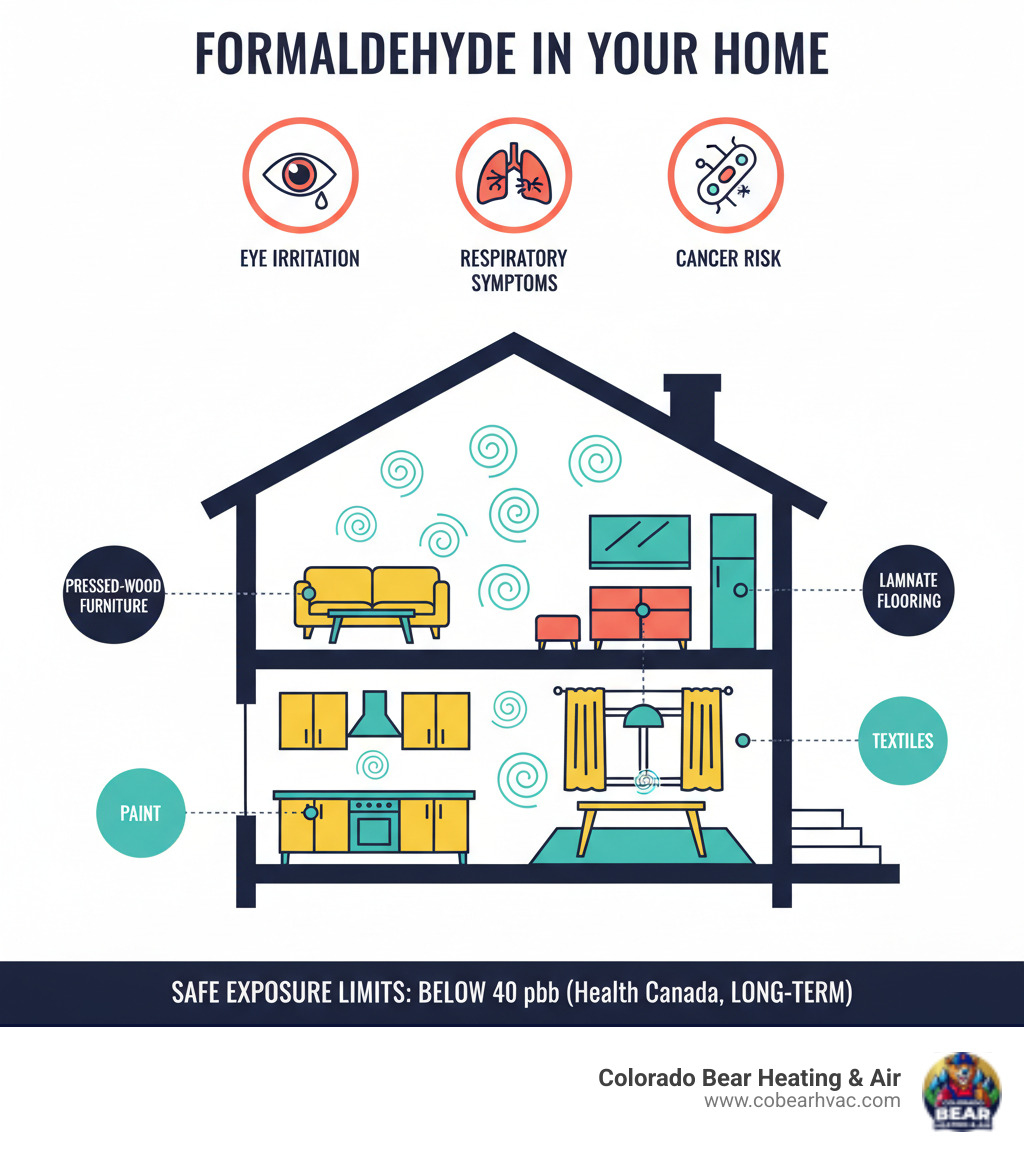
What is Formaldehyde and Why Is It a Concern?
Formaldehyde (H₂-C=O) is a colorless gas with a sharp, pickle-like smell. It's classified as a Volatile Organic Compound (VOC) because it easily vaporizes at room temperature, turning into a gas that floats through your home. This process is called off-gassing.
While formaldehyde occurs naturally (e.g., from forest fires and even in our own bodies as a metabolic intermediate), the formaldehyde air pollution we worry about comes from manufactured products. The key issue is accumulation. Outdoors, natural formaldehyde disperses to low concentrations, typically around 1–4 µg/m³. Indoors, however, it gets trapped. Levels in conventional homes can be 10 times higher than outdoors, and in newly renovated spaces, they can be over 20 times higher.
This off-gassing can continue for months or even years, creating constant exposure. Unlike some pollutants, formaldehyde often makes its presence known immediately through eye or throat irritation. Its chemical reactivity also means it can react with other substances in your air (like ozone) to form even more formaldehyde. Understanding this invisible, persistent pollutant is the first step toward clearing your air. For a deeper look, see our guide on why your indoor air quality matters.
Uncovering the Sources: Where Formaldehyde Hides in Your Home
The formaldehyde affecting your family is likely already in your living room, kitchen, and bedroom. Understanding its common hiding spots is the first step to reducing your exposure.
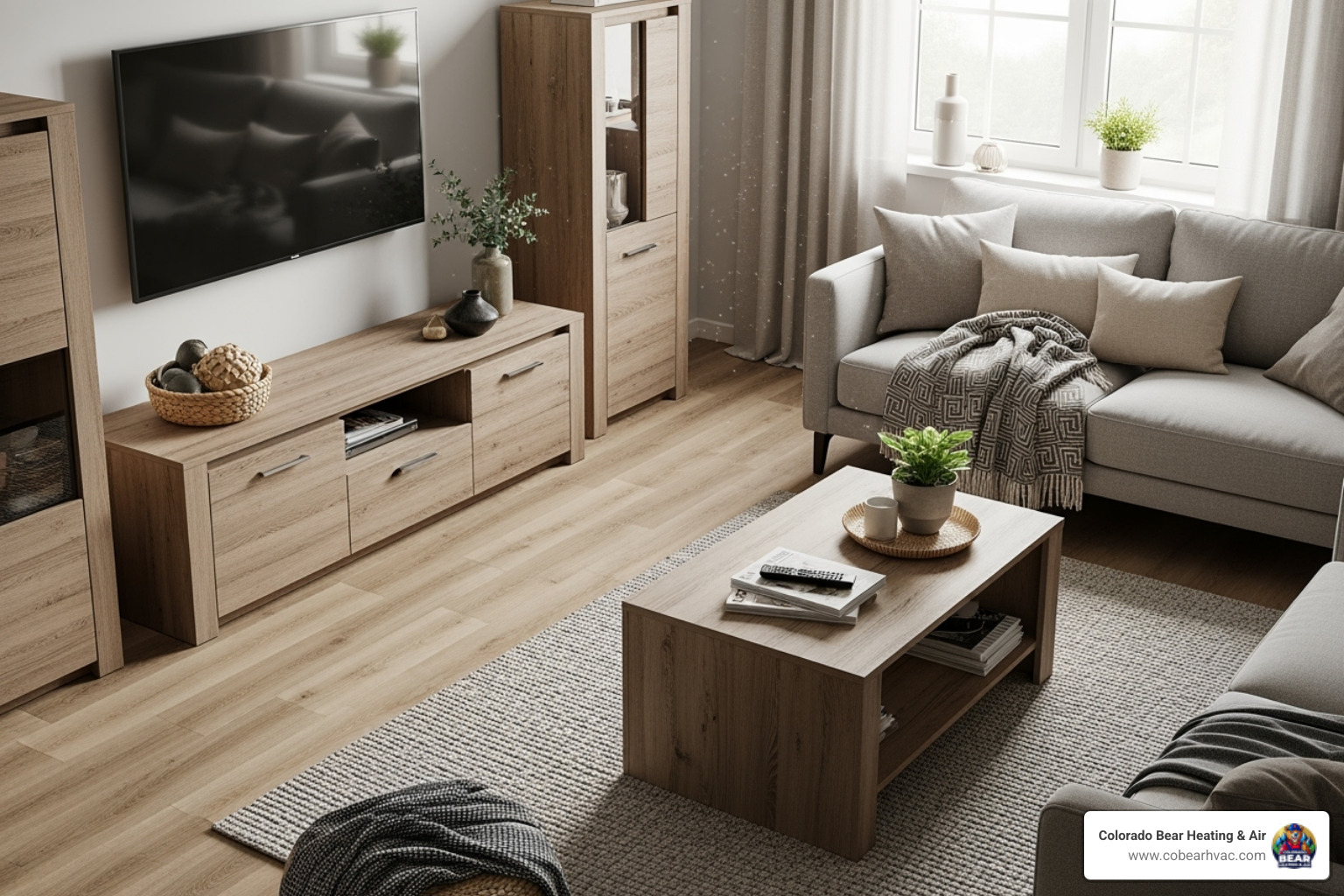
Building Materials and Furniture: The Biggest Culprits
The single largest source of formaldehyde air pollution in most homes is pressed-wood products like particleboard, medium-density fiberboard (MDF), and plywood. These materials are used in cabinetry, furniture, shelving, and sub-flooring. The problem lies in the resins used to bind wood particles together.
| Resin Type | Common Use | Formaldehyde Emission Rate | Notes |
|---|---|---|---|
| Urea-Formaldehyde (UF) | Interior pressed wood products (particleboard, MDF, hardwood plywood paneling) | Higher | Easily broken down by heat and humidity, leading to significant off-gassing. Used in most indoor furniture and cabinetry unless specified otherwise. |
| Phenol-Formaldehyde (PF) | Exterior-grade pressed wood products (e.g., construction plywood) | Considerably Lower | More stable and less prone to off-gassing. Used where moisture resistance is needed, like exterior siding or subflooring. |
Urea-formaldehyde (UF) resins are the main offenders, used in most interior-grade products. They break down easily, releasing formaldehyde for years. MDF is a particularly high-emitter. In contrast, phenol-formaldehyde (PF) resins, found in exterior-grade products, are more stable and release far less formaldehyde. When possible, choose solid wood furniture or look for products certified as low-formaldehyde or no-added-formaldehyde (NAF). California's Proposition 65 offers helpful information on low-formaldehyde building materials.
Other Common Sources
Beyond pressed wood, formaldehyde is found in:
- Adhesives and glues used in construction and furniture.
- Paints, coatings, and wallpaper.
- Permanent-press fabrics (wrinkle-resistant clothes and curtains).
- Cosmetics and personal care products (check labels for formaldehyde-releasing preservatives).
- Combustion sources like tobacco smoke, gas stoves, and unvented heaters.
How Temperature and Humidity Increase Emissions
Temperature and humidity act as accelerators for off-gassing. Higher heat and moisture cause the resins in building materials and furniture to break down faster, releasing more formaldehyde. This is why levels often spike during hot, humid summer months. In the Denver Metro Area, using your air conditioner to control temperature and managing humidity levels can help slow down these emissions and improve your indoor air quality.
The Health Risks of Formaldehyde Air Pollution
Even though it's invisible, the health impacts of formaldehyde air pollution are very real, ranging from immediate irritation to serious long-term disease.
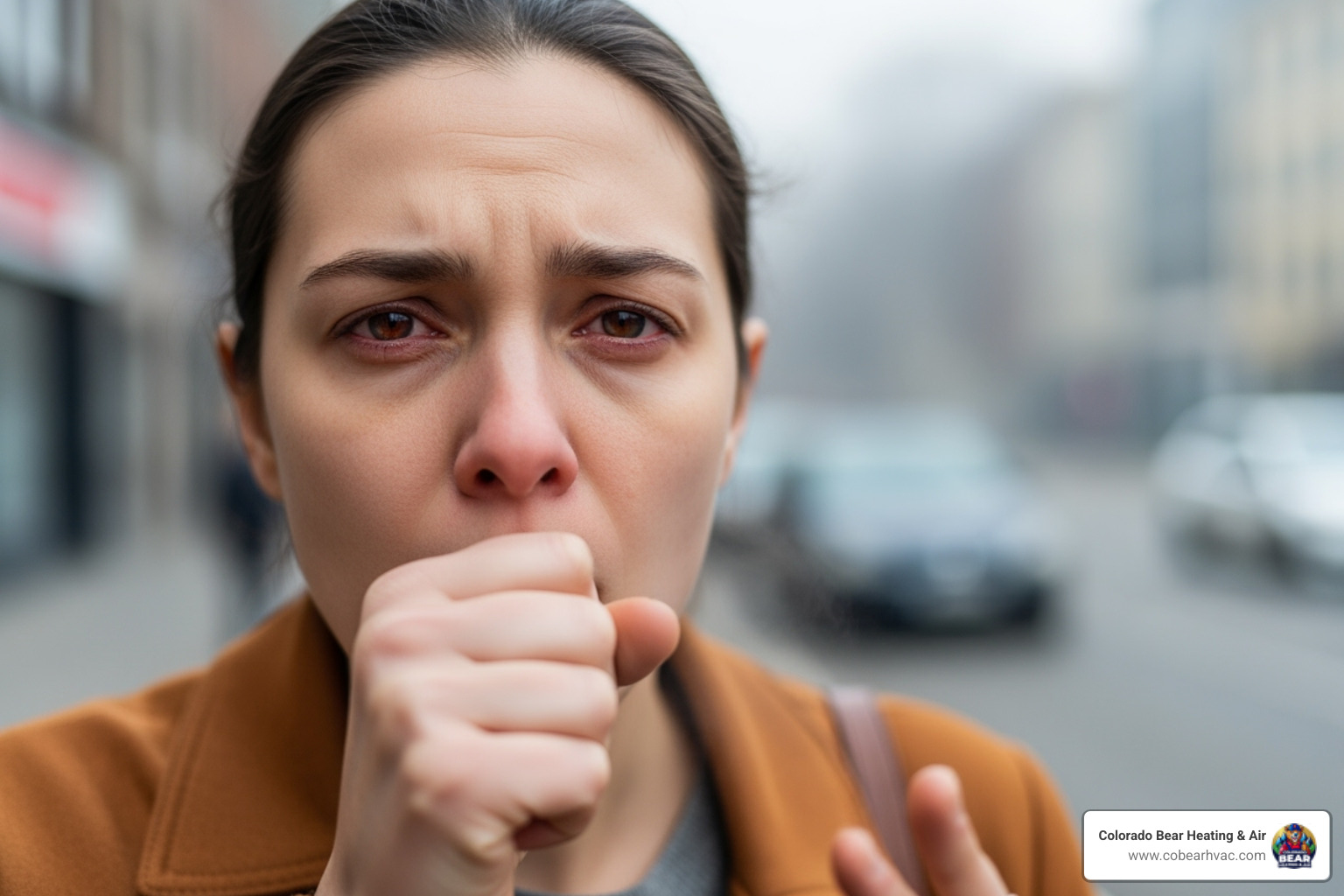
Short-Term and Long-Term Health Effects
Exposure to formaldehyde can trigger a range of symptoms. The severity often depends on the concentration and duration of exposure.
Short-Term Effects (Immediate Irritation):Because it irritates mucous membranes, formaldehyde can quickly cause:
- Watery, burning eyes
- Scratchy throat and nose
- Coughing and wheezing
- Headaches, nausea, and fatigue
- Skin rashes
For people with asthma, even low levels can trigger attacks. Health Canada's short-term exposure limit of 100 ppb is designed to prevent this sensory irritation, but sensitive individuals may react at lower levels. For a detailed overview of health effects from formaldehyde exposure, the Agency for Toxic Substances & Disease Registry is a comprehensive resource.
Long-Term Risks (Chronic Exposure):The most serious long-term risk is cancer. The International Agency for Research on Cancer (IARC) classifies formaldehyde as a Group 1 carcinogen, meaning it is known to cause cancer in humans. It is strongly linked to nasopharyngeal cancer (a cancer of the upper throat) and has a potential connection to myeloid leukemia.
Vulnerable Populations
Certain groups are more susceptible to the effects of formaldehyde:
- Children: Their developing respiratory systems, faster breathing rate, and time spent indoors make them especially vulnerable. Long-term exposure is linked to an increased risk of developing asthma.
- The Elderly: Weakened immune systems and pre-existing health conditions can increase sensitivity.
- People with Respiratory Conditions: Those with asthma or COPD can experience worsened symptoms and frequent attacks.
- Chemically Sensitive Individuals: Some people react to formaldehyde at very low concentrations that others don't notice.
Measuring and Understanding Formaldehyde Levels
Since you can't always see or smell formaldehyde, how do you know if it's a problem? Understanding typical levels and safety limits is key to making informed decisions about your home's air.
Typical Levels vs. Recommended Safety Limits
There's a stark difference between outdoor and indoor formaldehyde air pollution.
- Outdoor Air: Typically very low, around 2.0 ppb.
- Conventional Homes: Average around 20 ppb (10x higher than outdoors).
- Manufactured Homes: Often higher, averaging 40 ppb.
- New/Renovated Homes: Can spike above 300 ppb shortly after new materials are installed.
So, what's considered safe? Health Canada provides clear guidelines:
- Short-Term Limit (1 hour): Below 123 µg/m³ (100 ppb) to prevent eye and throat irritation.
- Long-Term Limit (8+ hours): Below 50 µg/m³ (40 ppb) to protect children with asthma from respiratory symptoms.
The goal for any home should be to keep levels as low as possible, ideally at or below the long-term limit.
Regulations and Standards for Formaldehyde
Fortunately, regulations help consumers choose safer products. The U.S. EPA TSCA Title VI and California's CARB Phase 2 standards set nationwide emission limits for composite wood products like particleboard, MDF, and plywood.
When shopping, look for product labels that indicate compliance with these standards or use terms like "no added formaldehyde" (NAF) or "ultra-low emitting formaldehyde" (ULEF). Third-party certifications also provide confidence:
- GreenGuard: Certifies products with low chemical emissions, including formaldehyde.
- Green Seal: Certifies products like paints and coatings that meet environmental leadership standards.
- Green Label Plus: A certification for low-emission carpets and rugs.
Choosing products with these labels is a straightforward way to reduce formaldehyde sources in your home.
Clearing the Air: Practical Steps to Reduce Formaldehyde
Knowing the risks of formaldehyde air pollution is the first step; taking action is the next. You can significantly reduce levels in your home through three key strategies: ventilation, source control, and air purification.
The Power of Ventilation
Fresh air is your most powerful tool. Ventilation dilutes and removes indoor pollutants.
- Open Windows: Regularly opening windows and doors, even for a few minutes a day, creates cross-ventilation and flushes out stale air.
- Use Exhaust Fans: Run kitchen and bathroom fans during and after cooking or showering to pull contaminated air and humidity outside.
- Consider Mechanical Ventilation: Systems like Heat Recovery Ventilators (HRVs) or Energy Recovery Ventilators (ERVs) provide a continuous supply of fresh, filtered air while recovering energy, making them an efficient year-round solution for the Denver climate.
Source Control and Smart Consumer Choices
The best way to deal with formaldehyde is to prevent it from entering your home in the first place.
- Choose Materials Wisely: Opt for solid wood furniture. If using pressed wood, look for products made with phenol-formaldehyde (PF) resins ("exterior-grade") or those certified as "no added formaldehyde" (NAF) or "ultra-low emitting formaldehyde" (ULEF). Look for certifications like GreenGuard or Green Seal. Find more tips at this resource on low-formaldehyde building materials.
- Air Out New Products: Let new furniture, cabinets, or building materials off-gas in a garage or well-ventilated area for several days or weeks before bringing them inside.
- Wash New Textiles: Wash permanent-press curtains and wrinkle-free clothing before use to remove formaldehyde-releasing resins.
- Control Combustion: Prohibit all smoking indoors and ensure fuel-burning appliances (gas stoves, furnaces) are properly vented and maintained.
Can Air Purifiers Remove Formaldehyde?
Standard air filters (like MERV-rated HVAC filters) capture particles but not gases like formaldehyde. To remove formaldehyde, you need a specific type of purifier.
- Activated Carbon Filters: These are essential. Activated carbon has a porous surface that traps VOCs, including formaldehyde. Look for purifiers with substantial carbon beds, as thin layers saturate quickly.
- PCO Technology: Some advanced systems use Photo Catalytic Oxidation (PCO) to break down formaldehyde molecules into harmless substances.
- Avoid Ozone Generators: Never use an air purifier that produces ozone. Ozone can react with other chemicals in your home to create more formaldehyde.
For comprehensive treatment, a whole-home purification system integrated with your HVAC is the most effective option. To learn more, see our guide on Choosing Right Air Purifier.
Frequently Asked Questions about Formaldehyde Pollution
We hear many of the same questions about formaldehyde air pollution from homeowners in the Denver Metro Area. Here are some quick answers.
How long does it take for formaldehyde to off-gas from new furniture?
Off-gassing is highest in the first few days and weeks, then drops significantly over the first year. However, it can continue at very low levels for years. The process is faster in higher heat and humidity. This is why it's best to air out new items in a garage or on a porch before bringing them into your living space.
Can you smell formaldehyde?
Yes, at high concentrations (typically above 100 ppb), formaldehyde has a distinct, sharp "pickle-like" odor. However, do not rely on your sense of smell for safety. Health effects like eye irritation and asthma triggers can occur at levels below the odor threshold for most people. The absence of a smell does not mean the air is safe.
Is formaldehyde in drinking water a concern?
For residential exposure, the primary health risk comes from inhalation of indoor air, not from drinking water. Formaldehyde breaks down quickly in water, and public water treatment facilities are very effective at removing it. Your focus for protecting your family from formaldehyde should be on improving your home's indoor air quality.
Conclusion
Take a deep breath. Understanding formaldehyde air pollution gives you the power to make that breath cleaner and healthier. We've seen that this invisible gas, released from common household items like furniture and flooring, poses real health risks, from immediate eye and throat irritation to long-term cancer risk.
But you are not helpless. By focusing on three key strategies—increasing ventilation, choosing low-emitting products (source control), and using the right air purification—you can dramatically reduce formaldehyde levels in your home. These practical steps empower you to create a safer environment for your family.
For over 20 years, Colorado Bear Heating & Air has provided honest advice and transparent solutions for indoor air quality to our neighbors in Castle Rock, CO, and the Denver Metro Area. We are committed to your family's comfort and health.
If you're concerned about your home's air quality, we're here to help. For a comprehensive assessment and personalized solutions, contact our experts. Learn more about our Indoor Air Quality services and take the first step toward a healthier home today.
Latest blogs

Apply now for flexible payment options
Get a decision in seconds with no impact to your credit score.



Testimonials
Service Areas
If you’re in Colorado Springs, The Mountains, or nearby areas, call us to confirm availability for installations.
.avif)















.avif)
.avif)
.avif)


